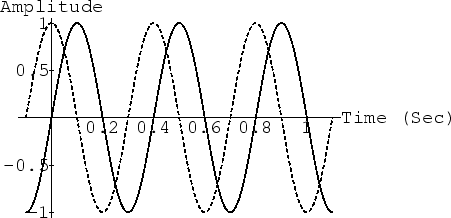NOTE: THIS DOCUMENT IS OBSOLETE, PLEASE CHECK THE NEW VERSION: "Mathematics of the Discrete Fourier Transform (DFT), with Audio Applications --- Second Edition", by Julius O. Smith III, W3K Publishing, 2007, ISBN 978-0-9745607-4-8. - Copyright © 2017-09-28 by Julius O. Smith III - Center for Computer Research in Music and Acoustics (CCRMA), Stanford University
<< Previous page TOC INDEX Next page >>
In-Phase and Quadrature Sinusoidal Components
From the trig identity
, we have
From this we may conclude that every sinusoid can be expressed as the sum of a sine function (phase zero) and a cosine function (phase). If the sine part is called the ''in-phase'' component, the cosine part can be called the ''phase-quadrature'' component. In general, ''phase quadrature'' means ''90 degrees out of phase,'' i.e., a relative phase shift of
.
It is also the case that every sum of an in-phase and quadrature component can be expressed as a single sinusoid at some amplitude and phase. The proof is obtained by working the previous derivation backwards.
Figure 5.2 illustrates in-phase and quadrature components overlaid. Note that they only differ by a relative
degree phase shift. (See §5.4 for the Mathematica code for this figure.)

